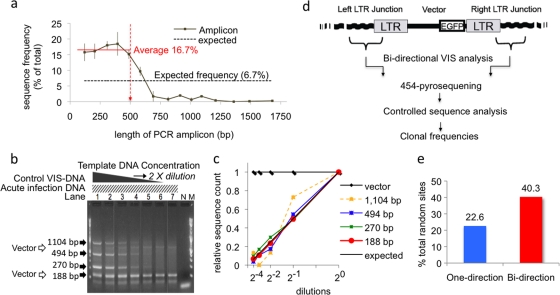FIG. 1.
Quantitative sequencing via pyrosequencing-based, bidirectional vector integration site analysis. (a) Sequencing efficiency for different lengths of DNA. The sequencing efficiency dropped for DNA of >500 bp but was relatively stable for DNA of ≤500 bp when 15 control DNAs (lengths ranging from 125 to 1,680 bp) were tested by the 454 pyrosequencing. (b and c) Analysis of the serially diluted control VIS DNA showed linear correspondence of the relative sequence frequencies to the dilution factor for DNA of <500 bp. A mixture of four control VIS DNAs was serially diluted and mixed with the VIS DNA from acutely infected cells (b). Panel B shows a 2% agarose gel run after the second PCR. Lanes 1 to 7, 2-fold serial dilutions of the control DNAs; lane N, water; lane M, 2-log DNA marker; dark arrows, four control VIS DNA; empty arrows, internal control (vector, LTR circles from acute infection). The relative sequence counts of the control VIS DNAs of <500 bp are in linear correlation with the expected values after 2-fold dilution (c). (d) The schematic view of the assay. The bidirectional VIS analysis enabled concurrent analysis of both the left and the right vector-host DNA junctions. Amplified junction DNA was then subjected to 454 pyrosequencing, followed by controlled sequence analysis. (e) Percentage of random vector integrants that can generate VIS DNA of <500 bp. The length of VIS DNA was determined based on the location of the nearest TaqαI site. With the one-directional approach, about 22.6% of random VIS generated VIS DNA of <500 bp. With the bidirectional approach, 40.3% could generate VIS DNA of <500 bp in either one of two directions (upstream or downstream from the vector).

